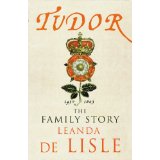Leanda de Lisle is the author of ‘Tudor: The Family Story’, ‘The Sisters Who Would Be Queen: The Tragedy of Mary, Katherine and Lady Jane Grey’ and ‘After Elizabeth’.
Follow Leanda de Lisle on Social Media:
Leanda’s website: www.leandadelisle.com
Twitter: @LeandadeLisle
Facebook: Leanda de Lisle
Many thanks to Leanda for answering my questions.
What does your book add to the existing works about the Tudors?
Most books on the Tudors begin in 1485 and dash through the reign of Henry VII to focus on Henry VIII, the Reformation, and the then the reign of Queen Elizabeth. I start much earlier, before the Wars of the Roses, with Henry VII’s grandfather Owen Tudor and his marriage to Queen Catherine of Valois. I then follow the lives of his descendants, legitimate and illegitimate, the well-known Tudors and the less well known, to create a full, but also intimate family portrait, that offers many surprises.
What surprised you most researching this book?
Gosh – I think I was surprised most by what the rulers had in common, how they were linked by very similar motives, at least until Queen Elizabeth…she made one dramatically different choice in remaining unmarried, though again that decision had political motives they would all have understood. I was surprised too by the significance of the life of Henry VIII’s niece, Lady Margaret Douglas, and how it has been overlooked. And I had a eureka moment when I realized why Richard III might have ‘disappeared’ the princes in the Tower rather than claiming they had died of natural causes, or some such.
Who do you think is mostly likely and least likely to be behind the disappearance of the Princes in the Tower?
I am sorry to say that I believe Richard III is most likely responsible for the disappearance of the Princes in the Tower. Least likely? Anne Neville, though she has become a popular candidate after the White Queen TV drama!
Are there any events during the Tudor period that aren’t as well-known as they should be?
Lots! But I think Elizabeth’s imprisonment of all her close female royal relatives is high on the list, i.e. her first cousin, Margaret Douglas, and then her first cousins once removed, Katherine Grey, Mary Grey, Anne Clifford, and of course, Mary, Queen of Scots! The whole lot of that generation!
Who did you enjoy writing about the most?
I really enjoyed the wars of the roses, though it was very hard to cover so much ground and keep it a good read. I had to work hard at my craft as a writer, as well as an historian, but it was worth it, I think!
Was Henry VII’s greatest legacy that people expected Henry VIII’s children to succeed him and not a distant ‘White Rose’ relative?
He gave the Tudor dynasty solid foundations and that was indeed, I think, his greatest legacy.
Does your portrayal of Lady Jane Grey and events surrounding her differ from in ‘The Sisters Who Would Be Queen?’
Yes. I now place responsibility for making the decision on Jane’s execution squarely at Mary’s door. I have also become much more sceptical about anything written concerning her reign that was published after her fall on 19 July 1553: if there is no corroboration I pretty much dismiss it.
How did you decide on the subject of the appendices (two of which are Jane related)?
They started off as foot notes, but I thought they were rather wasted as such and that readers might enjoy them more this way – like after dinner chocolates.
Why did you use the Somerley Portrait (‘originally identified as Lady Jane Grey, perhaps Margaret Douglas’)?
Good question: I saw it on Stephan Edward’s excellent somegreymatter website, and wondered if it could be Margaret, given the cufflinks are marked MD and now it’s out there, people can debate the matter. In all honesty though think a more likely candidate is the miniature usually described as Katherine Howard – it looks very like the pictures of Margaret in middle and old age, and it is quite possible she would have been painted wearing royal jewellery as this figure is. She was lent jewellery by Henry VIII, and was given it too – Mary Tudor gave her masses of jewellery for her wedding. As for Katherine Howard – well, people didn’t much hang on to pictures of beheaded Queens, which is why there are no surviving contemporary portraits of Anne Boleyn or Jane Grey.






































